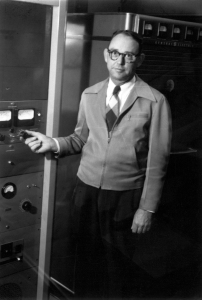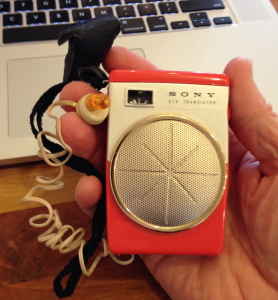 “Just as newspapers fell off a cliff, radio is about to follow. It’s going to happen faster than anyone expects. And of course, it will be replaced by a new thing, a long tail of audio that’s similar (but completely different) from what we were looking for from radio all along. And that audience is just waiting for you to create something worth listening to.”
“Just as newspapers fell off a cliff, radio is about to follow. It’s going to happen faster than anyone expects. And of course, it will be replaced by a new thing, a long tail of audio that’s similar (but completely different) from what we were looking for from radio all along. And that audience is just waiting for you to create something worth listening to.”
Tag Archives: Radio
The transistor radio
From Walter Isaacson’s The Innovators:
 “Transistors were being sold in 1954 to the military for about $16 apiece. But in order to break into the consumer marker. Haggerty insisted that his engineers find a way to make them so that they could be sold for less than $3. They did. He also developed a Jobs-like knack, which would serve him then and in the future, for conjuring up devices that consumers did not yet know they needed but would soon find indispensable. In the case of the transistor, Haggerty came up with the idea of a small pocket radio. When he tried to convince RCA and other big firms that made tabletop radios to become a partner in the venture, they pointed out (rightly) that consumers were not demanding a pocket radio. But Haggerty understood the importance of spawning new markets rather than merely chasing old ones. He convinced a small Indianapolis company that built TV antenna boosters to join forces on what would be called the Regency TR-1 radio. Haggerty made the deal in June 1954 and, typically, insisted that the device be on the market by that November. It was. The Regency radio, the size of a pack of index cards, used four transistors and sold for $49.95. It was initially marketed partly as a security item, now that the Russians had the atom bomb. “In event of an enemy attack, your Regency TR-1 wiU become one of your most valued possessions,” the first owner s manual declared. But it quickly became an object of consumer desire and teenage obsession. Its plastic case came, iPod-like, in four colors: black, ivory, Mandarin Red, and Cloud Gray. Within a year, 100,000 had been sold, making it one of the most popular new products in history.”
“Transistors were being sold in 1954 to the military for about $16 apiece. But in order to break into the consumer marker. Haggerty insisted that his engineers find a way to make them so that they could be sold for less than $3. They did. He also developed a Jobs-like knack, which would serve him then and in the future, for conjuring up devices that consumers did not yet know they needed but would soon find indispensable. In the case of the transistor, Haggerty came up with the idea of a small pocket radio. When he tried to convince RCA and other big firms that made tabletop radios to become a partner in the venture, they pointed out (rightly) that consumers were not demanding a pocket radio. But Haggerty understood the importance of spawning new markets rather than merely chasing old ones. He convinced a small Indianapolis company that built TV antenna boosters to join forces on what would be called the Regency TR-1 radio. Haggerty made the deal in June 1954 and, typically, insisted that the device be on the market by that November. It was. The Regency radio, the size of a pack of index cards, used four transistors and sold for $49.95. It was initially marketed partly as a security item, now that the Russians had the atom bomb. “In event of an enemy attack, your Regency TR-1 wiU become one of your most valued possessions,” the first owner s manual declared. But it quickly became an object of consumer desire and teenage obsession. Its plastic case came, iPod-like, in four colors: black, ivory, Mandarin Red, and Cloud Gray. Within a year, 100,000 had been sold, making it one of the most popular new products in history.”
“More fundamentally, the transistor radio became the first major example of a defining theme of the digital age: technology making devices personal. The radio was no longer a living-room appliance to be shared; it was a personal device that allowed you to listen to your own music where and when you wanted—even if it was music that your parents wanted to ban.”
I wanna be a DJ or a cowboy
You know how when you cut down the rain forest you destroy the natural habitat of some exotic wild animals and they become extinct? Say goodbye the Spotted American DJ. It’s all there in an excellent (and depressing) story by Clay Barbour in The Virginian-Pilot:
10 companies control two-thirds of the country’s listeners and ad revenue; two of them – Clear Channel and Infinity Broadcasting – own more than 40 percent of all stations.
Edison Research found that as many as 75 percent of 12- to 24-year-olds were listening to online radio, with nearly half of them using their phones to do so while in the car. Essentially, if you are younger than a certain age, you don’t listen to terrestrial radio anymore.
Many of you have ready my nostalgic ramblings about my dozen years as a small town radio DJ in the 70s. (sigh) Really glad I got to ride the range before all the media sod busters arrived.
Changing listening habits
“A new Edison research study warns that among the six most common places where listeners consume audio media, broadcast radio dominates in just two of them (in car, at home); is tied with Internet radio for two (at work, on public transportation); and is defeated by Internet radio in two (while working out, while walking around). Another red flag in the study for broadcasters is that 50 percent of at-work listeners who listen to Internet-radio-only stations/services (that is, stations/services that don’t broadcast on FM/AM) have replaced their FM/AM listening time with Internet-radio-only stations/services.”
“According to Triton Digital, at any given moment among online listeners (M-F 6am-8pm), Pandora has more than twice the audience of all of the radio stations owned by Clear Channel, CBS, Cumulus, Entercom and the next seven broadcasting companies combined.”
— All Things Digital
Asking the right questions
“…the implicit assumption is that radio’s past must be sustained into the future, and with a few tweaks here and there we can dial up our relevance […] and dial down our risk. This is equivalent to the consumer products company that asks “how can we make a new product that we can successfully sell?” – as long as that product is envisioned, made, and sold to fit with all the previous products the company has sold in the past.” — Mark Ramsey
Heavy snow knocked out power to our house yesterday so as darkness fell, I built a fire, turned on some solar LED lamps and dug out a transistor radio. I didn’t sample a lot of stations but the ones I listened too sounded… quaint?
I probably haven’t listened to a full hour of “terrestrial radio” in the last 5 years so what I heard felt strange in my ears. The phony DJ voices; snatches of Alice Cooper’s syndicated show (shudder)… but the most jarring was the lack of control over my experience. Don’t like a song? Well, tough shit, just gotta wait till it’s over and hope you like the next one better.
I’m going to take it on faith there are radio stations (somewhere) breaking new ground and reinventing themselves for the new media world in which they find themselves. If you know of one, drop a link (or just the call letters) in the comments.
Behind Your Radio Dial
Before television took over the airwaves, Rockefeller Center was home to the National Broadcasting Company during the golden age of radio. This promotional film from around 1948 chronicles the rise of the media company from a small collection of 20 affiliated stations, formed in 1926, to more than 170 stations two decades later. The 24-minute documentary, courtesy of the Prelinger Archive, introduces the network and goes behind the scenes at Rockefeller Center, peeking into the mail room, sound recording studios, and music library.
The documentary closes with a look at the network’s budding television enterprise. “Adding sight to sound, [NBC] opened an electronic window” when it launched the first commercial television station in 1941, the narrator explains. “More than two decades of NBC radio have been dedicated to the spirit of public service. Now, in bringing television, network television, out of the laboratory and into your living room, NBC rededicates itself in this same spirit to provide the greatest medium of mass information and mass entertainment in the world.” Radio junkies and30 Rock fans alike will enjoy this journey back in time.
Old radio commercials (KBOA)
A YouTube playlist featuring oral history of KBOA, Kennett, MO. All of these are available as MP3 files at www.KBOA830.com.
Radio’s Salvation?
“Television is the last protected media business,” but it’s going to get disrupted. For one, once televisions are computers, analytics of who watches will get more accurate than Nielsen panels. “Everyone knows that if we go to actual measurement, ad rates will collapse because the numbers aren’t as good as Nielsen makes them look.”
DAR: Tivo for radio
This begs the question, “Does my local radio station have programs so compelling I want to record them and listen later?” Let’s hope so. If you have –or plan to– tried DAR, let me know what you think. (via Roger Gardner)
The end of radio coverage maps?
A radio station coverage map is just what it sounds like: a cirle showing how far your station’s signal reaches. The bigger the circle the better. Now a new BMW option might make coverage maps less important (obsolete?)
Yes, I know, not everyone can afford a BMW but is there any doubt this technology will find its way into every vehicle? Not for moi.
Mark Ramsey sees the car as “a digital lifestyle accessory” and wonders how broadcasters fit into the consumer’s mobile digital lifestyle?
“Maybe it’s with unique and exclusive content. Maybe it’s with digital bells and whistles that make your content sing. It’s not with the same old same old. And no number of debates about FM on mobile phones will solve this problem for you.”
On more than one occasion I’ve wondered what would I do to stay fresh and relevant if I were running a radio station. How might I insure that my station was on that BMW dashboard/iPhone? And I don’t have a good answer. But smarter folks than I are figuring this out.
